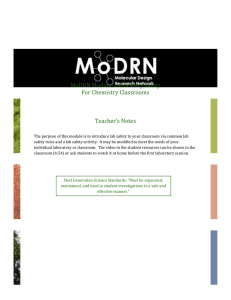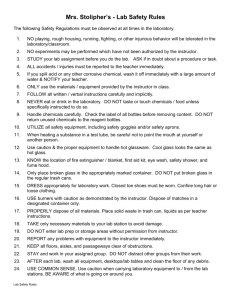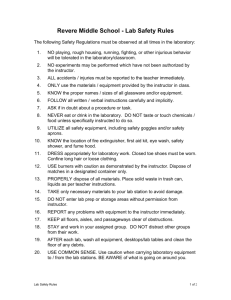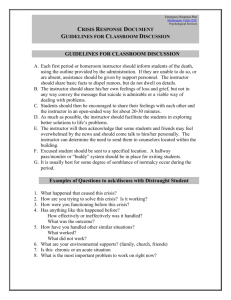WORD
advertisement
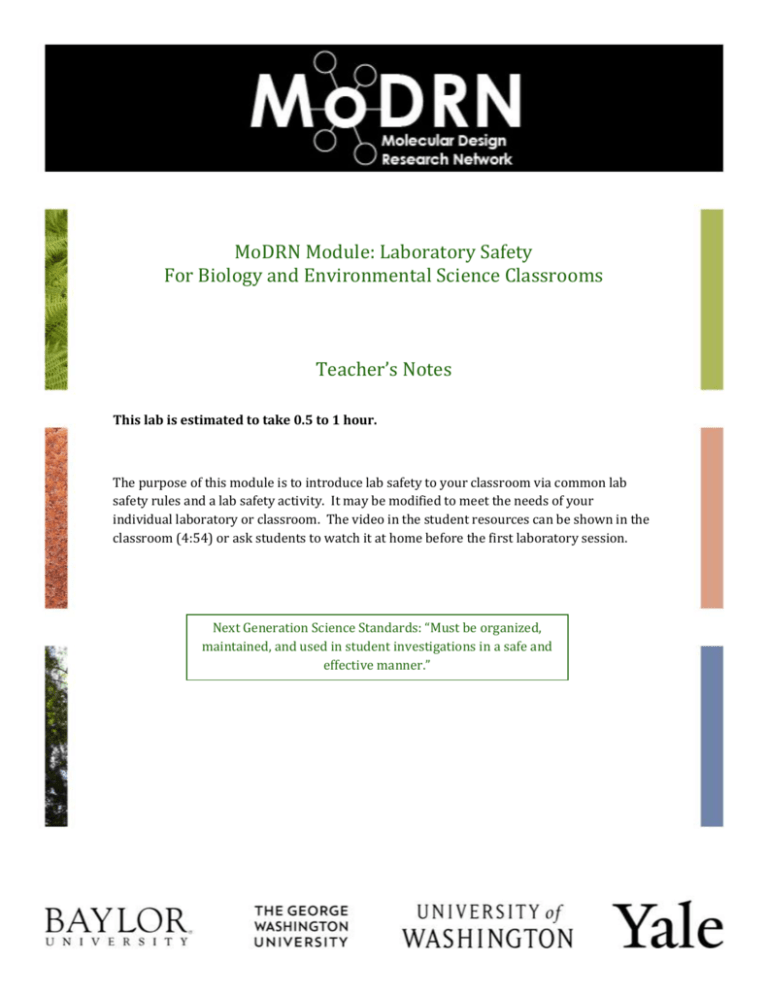
MoDRN Module: Laboratory Safety For Biology and Environmental Science Classrooms Teacher’s Notes This lab is estimated to take 0.5 to 1 hour. The purpose of this module is to introduce lab safety to your classroom via common lab safety rules and a lab safety activity. It may be modified to meet the needs of your individual laboratory or classroom. The video in the student resources can be shown in the classroom (4:54) or ask students to watch it at home before the first laboratory session. Next Generation Science Standards: “Must be organized, maintained, and used in student investigations in a safe and effective manner.” Supplemental Readings The following are supplemental readings for you and your students to understand various aspects of laboratory safety guidelines for the classroom and beyond. American Chemical Society. (2014). Chemical science safety in the classroom. Retrieved from http://www.acs.org/content/acs/en/education/policies/safety.html Environmental Health & Toxicology. (2014). Enviro-health links: Laboratory safety. Retrieved from http://sis.nlm.nih.gov/enviro/labsafety.html Flinn Scientific. (2014). Student safety contract. Retrieved from http://www.flinnsci.com/media/396468/safety_contract_hs.pdf Laboratory Safety Institute. (2014). Laboratory safety guidelines. Retrieved from http://www.labsafetyinstitute.org/epubs/LSG_English.pdf National Science Teachers Association. (2014). Safety in the science classroom, laboratory, or field sites. Retrieved from http://www.nsta.org/docs/SafetyInTheScienceClassroomLabAndField.pdf National Science Teachers Association Safety Advisory Board. (2014), Overcrowding in the instructional space. Retrieved from http://www.nsta.org/docs/OvercrowdingInTheInstructionalSpace.pdf OSHA. (n.d.). Safety and health topics: Laboratories. Retrieved from https://www.osha.gov/SLTC/laboratories/ Student Learning Objectives At the end of this activity, the student will be able to: Recognize common rules that allow for a safe working environment in the laboratory and/or classroom Find the location of certain safety items such as fire blankets, fire alarms, eye wash stations, etc. State their intention to follow the safety rules as reviewed in class and adhere to them for every experiment or activity, laboratory or classroom-based. Watch After the Rainbow: a video safety message focusing on preventing accidents in high school chemistry laboratories http://www.csb.gov/videos/after-the-rainbow/ Listen Remember: Your teacher is the only person in the classroom with the most knowledge and tools to keep you safe. Paying attention and listening to everything they say or post is important to avoid injury or possibly even death. Horseplay, joking around, pretending not to care, or showing off in the laboratory is dangerous. You could hurt yourself or your friends. So be sure to always listen, pay attention, and take seriously everything you do in the laboratory, small or large. Laboratory Safety Rules 1. Follow directions precisely and completely. The directions have been carefully designed to avoid accidents. Your instructor will point out hazards before you begin so pay attention! 2. Safety Goggles. Goggles with side splash guards are required by law and are available at the college bookstore. Safety glasses are not permitted. 3. Clothing/Long Hair. Students must wear proper clothing in the laboratory. Sandals and shorts should not be worn on lab days. Long hair should be tied up in a band. Wear OLD clothing in the laboratory. 4. Place bags, purses, coats, etc… on the shelves near the door. 5. Never smoke or eat in the laboratory. No food is allowed in lab. 6. Use waste containers provided by your instructor. Make sure you read the labels on waste containers and notify the instructor when the containers are full. 7. Excess chemicals should never be returned to the reagent containers. The entire supply might become contaminated. Instead, give your excess to other students or put them in the waste containers. 8. Broken Glass. Dispose of broken glass in the blue and white cardboard boxes provided in the laboratory. Do not place broken glass into the trash can. Use a dustpan and brush provided—do not use your fingers to pick up the glass. 9. Know the location and the use of the first aid kit, fire extinguishers, the emergency shower and the eye wash in case of emergencies. 10. Keep the benchtop clean and dry at all times. Clean with soap and water at the end of the period. 11. Do not look down into a test tube! Angle test tubes away from people as you heat them. Keep your face away from any chemicals being heated in open apparatuses. The tubes may erupt like geysers, so point them away from people. 12. Sniff!! Do not inhale!! When attempting to detect chemical odors, sniff gently. Most chemical vapors are at least irritating if not toxic. 13. Do not pick up hot objects. Let items cool or use oven mitts/tongs to move hot items. 14. Always pour concentrated acids into water carefully. Any concentrated reagent should be handled with care. Always pour concentrated sulfuric acid into water down the side of the container. Never pour water into concentrated sulfuric acid. 15. Wash it off with water! If any chemical is splashed on you, wash it off with PLENTY of water. Then report to the instructor, if further treatment is needed. 16. Always wash your hands before leaving lab. 17. Mercury vapors are poisonous. If some mercury is spilled (like by breaking a thermometer), it must be picked up immediately and properly disposed of. Notify the instructor. 18. Do not perform unauthorized experiments. One of the common sources of accidents is the performance of experiments that have not been explicitly assigned or approved by the instructor. 19. When in doubt, ask your instructor. Your instructor is in the laboratory to answer any questions that come up in the course of the quarter's work. 21. Dispose of all biological specimens in the proper disposal area as designated by your teacher. 22. Carefully dispose of sharps in the designated container for sharps. DO NOT put in paper, plastic, or other materials into this container. SHARPS ONLY! 20. Emergency. In case of an accident, notify your instructor immediately. Laboratory Safety Worksheet Name__________________________________________________ Sketch the floor plan of the laboratory. Indicate the locations of exits, eyewash, ventilation hoods, fire extinguisher, first aid kit, sharps container, and safety shower. What are the laboratory rules about safety goggles? _________________________________________________________________________________________________________ _________________________________________________________________________________________________________ _________________________________________________________________________________________________________ _________________________________________________________________________________________________________ If you take too much of a chemical when working, what are you supposed to do with the excess? _________________________________________________________________________________________________________ _________________________________________________________________________________________________________ _________________________________________________________________________________________________________ _________________________________________________________________________________________________________ Should you pick up broken glass with your fingers? Does the broken glass go in the trash can? If not, where does it go? _________________________________________________________________________________________________________ _________________________________________________________________________________________________________ _________________________________________________________________________________________________________ _________________________________________________________________________________________________________ When working with preserved specimens, where should you dispose of them when finished? _________________________________________________________________________________________________________ _________________________________________________________________________________________________________ _________________________________________________________________________________________________________ _________________________________________________________________________________________________________ What is the correct way to dispose of chemicals at the end of the laboratory period? _________________________________________________________________________________________________________ _________________________________________________________________________________________________________ _________________________________________________________________________________________________________ _________________________________________________________________________________________________________ Why should you wash your hands before leaving lab? _________________________________________________________________________________________________________ _________________________________________________________________________________________________________ _________________________________________________________________________________________________________ _________________________________________________________________________________________________________ I have read and will comply with all stated laboratory safety rules. Signature ______________________________________ Classroom ____________________________ Date ___________________ The Safety Rules and Worksheet are license by Washington State Colleges under a Creative Commons Attribution 3.0 United States License.
